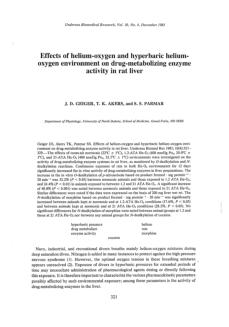
In this document David E. Yount (US navy at Hawaii)
explains the advantages of his Variable Permeability Model
(VPM ) and says the following to introduce it:
With the development of a detailed mathematical model
describing bubble formation in aqueous media, it is now
possible to quantify various degrees of nucleation and
place any given dive profile at a more realistic position on
the nucleation scale. The methods of Haldane and of Hills
may then be regarded as limiting special cases of a more.
general decompression theory that should someday be
applicable to the whole range of hyperbaric and
hypobaric situations.
The excat date of publication of this document is not
indicated
.



This document was written by Nishi and Lauckner.
It describes the Kidd-Stubbs decompression model and its
adaptation to the DCIEM 1983.


Scientific papers 1980 - 1985

This paper aims to comprehensively search and explain
the solubility of gases, liquids, and solids in liquids.


This document explains the development of the Variable
Permeability Model (VPM ) by using transparent gelatin
samples subjected to various pressure schedules. The
authors explain that this technique is well suited for such a
study as it yields a definite number of bubbles that are can
be counted and measured.
.



In this paper, David E. Yount explains the evolution of a
nucleus from one equilibrium state to another and
investigates the statistical process by which the equilibrium
size distribution of an entire population of nuclei may be
generated or regenerated.
Date of publication: March 1982


This document describes the investigations and tests made
for programming wrist-worn underwater decompression
computers used by US Navy divers.
Date of publication: 1983
Edward Deforest Thalmann (03/04/45 – 24/07/04) was
an American hyperbaric doctor of the US Navy.
He worked on the previous version of the US Navy tables
and developed Algorithms for diving computers and
compute dive tables.



This document describes the procedure for the calculation
of multilevel dives using the repetitive groups of the US
Navy tables.
Date of publication: September 1983
Note that multilevel dive tables are present in the DCIEM
and Comex tables.



The pulmonary surfactant is a mixture of lipids and
proteins secreted by the epithelial cells into the alveolar
space. Its primary function is to reduce the surface tension
at the air/liquid interface in the lung.
This study aims to identify the relationship between
hydrophobicity and respiratory distress syndrome.
(Hydrophobe = that repels water)
Note that this document is more a medical document
than a document related to diving. However, it allows us
to understand the importance of the surfactant in
respiration and thus gas exchanges in the lungs.



This document is the continuation of the document #6:
“Testing of decompression algorithms for the use in the US
Navy underwater decompression computer”.
Date of publication: January 1984



As indicated in the title, this document discusses the
thermal limits according to the depth and the duration of
the dive and the parts of the body exposed.
Date of publication:1984






This report describes some researches made by doctor
Thalman regarding heliox diving. The descriptions of cases
of DCS and treatment results are indicated in the
document with the details of the computer algorithm,
decompression schedules tested, and the final
decompression tables.
The pertinence of the final decompression model to
HeO2 bounce and saturation diving is also discussed.



This study, published in 1981, has been used by other
scientists in further studies and manuals. It investigates
noise levels with helmets and face-masks when using tools
such as HP water blasters. Note that apart from the KMB
17, the helmets and masks taken as reference are no more
produced. However, similar models are still in sold.
.







Author: Akira Ishiyama
The gas composition of intravascular bubbles produced by
decompression was investigated in rabbits using gas
chromatography. The animals were exposed to 8 ATA for
30 min. All samples of bubbles were taken from the
animals under a 0.2 ATA pressure gradient so that no air
could enter the sampling system from the outside.
The percentage of carbon dioxide in the bubbles tended
to decrease at first and then increased with post-
decompression time. On the other hand, the percentage
of oxygen tended to change in the opposite manner.



Decompression sickness has in the past been defined as
an overt illness that may appear in a human being while
diving or following a reduction in environmental pressure
sufficient to cause bubble formation and/or growth
from the gases dissolved in the tissues. Other terms have
been legitimized by use to have an equivalent meaning,
despite the opinions of experts that it would be more
desirable either to not use such terms at all or else to use
them only in relation to a particular type of decompression
sickness: such terms include caisson disease, compressed
air illness, and the bends.



Authors: Paul K Weathersby & Blaine Hart
Several sets of equal risk air decompression tables were
calculated using a new methodology. Empirical
decompression risk models were used to predict the
probability of decompression sickness (DCS) for a given
pressure exposure. These probabilistic models, earlier
shown to have e considerable ability to separate tabulated
experimental air dives according to DCS risk, were used to
choose decompression schedules with an acceptable risk.



Doctor Alfred Buhlman (1923-1994) was a prolific
scientist from Switzerland well known for his sport diving
decompression algorithms, such as the ZHL-16 model still
used in many diving computers. However, he also
developed decompression models for commercial and
military diving.
This document, published in May 1984, describes the
algorythm ZH-L-12.




Authors: Brumon Kiernikowicz & Stefan Teresinky
This paper presents a case of pulmonary barotrauma in a
scuba diver. Swallowing water and respiratory arrest
during the ascent caused the trauma.
Symptoms from the respiratory system (including the
Behnke's symptom) appeared several minutes after the
completion of the dive and were not severe.
However, symptoms from the peripheral nervous system,
which appeared later, increased rapidly until the seizure
episode and loss of consciousness.

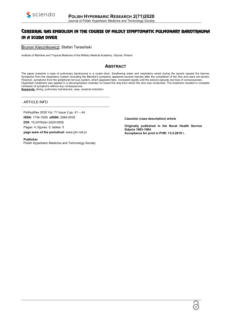

This publication summarizes a workshop organized by the
European Undersea Biomedical Society and the
Norwegian Petroleum Directorate in November 1983. It is
no longer edited, and for this reason, and because the
topics discussed are essential, we have decided to publish
it. It is divided into four sections, the first three of which are
introduced by keynote papers, followed by an individual
discussion on each article, and concluded with a general
discussion. The fourth session is a general discussion of the
whole meeting.



Author: Peter O. Edel
This document , published in 1980, discusses 336 depth-
time combinations of air decompression tables selected
from the U.S. Navy and British schedules that were
individually analyzed by a computer. In addition to 97
schedules tested by the C Experimental Diving Unit in
the development of Mimed Gas Scuba tables were
analyzed to compare the computer analysis with
manned test data.
.



These proceedings contain seven invited papers which
were presented during a special session on coldwater
diving at the American Academy of Underwater
Sciences' Coldwater Diving for Science - 1987
Symposium, October 29 to November 1, 1987 at the
University of Washington, Seattle.


IB.G. D'Aoust, R. White, H, Swanson, R. Dunford
This paper, published in 1989, discusses the advantages
associated with isobaric experiments involving either
transient or steady-state counter-diffusion. The authors
investigated the potential advantages and/or hazards
associated with sequentially breathing of inert gas/oxygen
mixtures using helium and nitrogen as the inert gases.


Authors: P Naquet, C. Lemaitre, J. C. Rostain
The data presented in this paper are based on 20
experimental dives, made either at Comex in Marseille or at
the French naval station in Toulon. The gas mixture was
helium-oxygen and helium-nitrogen-oxygen. Only the
experimental dives in which subjects reached or went
below 300m are taken into account. These experiments
have shown that the intensity and type of symptoms vary
according to the experimental conditions and the tested
subjects, and they have made it possible to establish
several general rules.



Click on the octopus
to return to the top
of the page



Authors: P. K. Weathersby, K. G. Mendenhall,E. E. Barnard,
L. D. Homer, S. Survanshi, and F. Vieras
The kinetics of xenon gas uptake and elimination were
measured by recording gas concentrations in seven
anesthetized dogs over a period of 7 hours. It was found
that the fastest exchange occurred in the lungs, and
progressively slower exchanges happened in the brain,
spinal cord, ears, peripheral joints, and shoulder (over 2
hours). The residence variance time (second moment) was
approximately four times the square of the mean
residence time. This ratio was consistent throughout the
body.Indications of unexpectedly high levels of xenon
solubility were also found in the ear and joint regions.


Author: Edward D. Thalmann
Between 1977 and 1982, the United States Navy
Experimental Diving Unit (NEDU) was tasked with
developing decompression protocols to be used with the
MK15 and MK16 Underwater Breathing Apparatus. The
protocols were designed to maintain a consistent oxygen
partial pressure of 0.7 ATA while using either helium or
nitrogen as a diluent. This manuscript outlines the
methodologies used during this project, as well as the
associated limitations.



Author: C.Y. Lin
An unusual circulatory state exists in humans immersed in
water at or near 35°C. This state is characterized by a
sustained and elevated stroke index, while the heart rate
changes only slightly. Therefore, the cardiac index
increases. Evidence supports the finding that the increase
in stroke volume is due to increased cardiac preload, and
that changes in afterload and contractility play a minor
role in affecting cardiac performance during immersion in
thermoneutral water up to the neck level.



Authors: C Blood, A. Hoiberg
Diving encompasses many activities and is subject to
numerous and varied risks for divers. Effective planning for
diving operations requires an understanding of the
conditions that contribute to the success or failure of the
mission.
The objective of this study was to identify the most
common underwater mishaps and the underlying factors
associated with diving accidents.



Authors: P.K. Weathersby, S.S. Survanshi, L.D. Homer, B.L.
Hart, R.Y. Nishi, E.T. Flynn, and M.E. Bradley
A large number of air dives were studied using a new
methodology. Several essentially empirical models of
decompression risk were considered, predicting the
probability of decompression sickness (DCS) for a given
pressure exposure, to avoid the infinitely sharp threshold
parameters that have characterized previous
decompression table calculations. The candidate models
used several different formulations of tissue gas exchange
kinetics and summed tissue overpressures calculated
during the dive to estimate decompression risk. They were
compared using statistics



Authors: O.I. Molvaer and E.H. Lehmann
There is a correlation between hearing loss and increasing
age, diving experience, and acoustic trauma. There is also
a significant increase in high-frequency hearing thresholds
in smokers compared to those who have never smoked,
and divers' high-frequency hearing thresholds are higher
than usual across all age groups. The authors conclude
that professional diving may cause a more rapid
deterioration of high-frequency hearing than in the
standard population and that smoking may be an
additional hazard to high-frequency hearing.

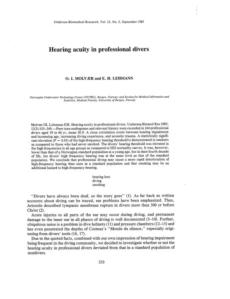

Author: C. Edmons
An audiometric examination was conducted on a group
of professional abalone divers who had experienced
significant exposure to dysbaric conditions. The findings
from this study demonstrated that over 60% exhibited
unsatisfactory high-frequency sensorineural hearing loss.
Half of these cases were unilateral, while the other half
were bilateral.



Authors: C. Blood and A. Hoiberg
The US Navy examined dive logs to identify the most
common accidents and underlying factors. Of the 1174
incidents reported in 706,259 dives, decompression
sickness and barotrauma were the most common. The
incidence of accidents increased significantly with
increasing depth. Selection or experimental dives,
saturation dives, and surface decompressions were
associated with an increased risk of incidents. Older divers
were disproportionately assigned to deep dives.

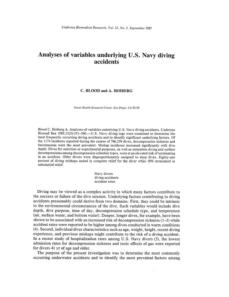

Authors: C.G. Bayne, W.S. Hunt, D.C. Johanson, E.T. Flynn,
and P.K. Weathersby.
Doppler detection has been promoted as a non-invasive
and sensitive indicator of impending decompression
sickness. The authors conducted a double-blind,
prospective clinical trial of Doppler ultrasound bubble
detection in simulated diving in 83 men with clinical
disease who were also treated. Diagnosis based solely on
Doppler signals did not correlate with the clinical
diagnosis.
Bubble scores were only slightly higher in the group with
clinical disease. The Doppler technique appears to have
no diagnostic value without additional clinical information.

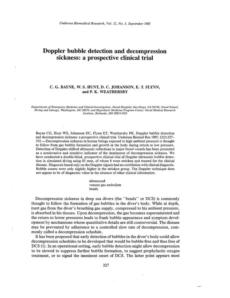

Authors: J. Parmentier, B. Shrivastav, and P. B. Bennett
This study reports on experiments investigating the effects
of halothane, a general anesthetic gas also known by the
brand name Fluothane, and hydrostatic compression on
the voltage-dependent sodium conductances in the squid
giant axon. The authors conclude that pressure and
halothane do not act antagonistically.



Authors: J.J.W. Sykes and L.J. Yaffe
The document's authors examined spinal cords from
animals affected by experimental decompression sickness
(DCS) to understand the varied responses to treatment
observed. Light microscopy of toluidine blue-stained
ultrathin sections from these animals revealed a noticeable
widening of the myelin sheath and a banded pattern,
indicating myelin disruption. These findings might explain
the treatment responses observed in patients and the
development of late lesions in the spinal cords of long-
term DCS survivors.

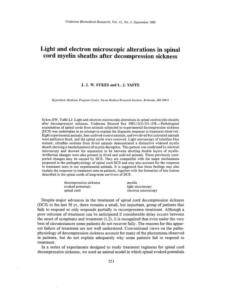

Authors: DR Leitch, JM Hallenbeck
Twenty-five anesthetized dogs were studied to determine
the optimal PO2 for treating delayed spinal cord
decompression sickness. After a 15-minute dive at 10 bar
and a rapid decompression, dogs showed signs of
decompression sickness monitored by somatosensory
spinal evoked potentials (SEP). Upon confirming DCS, the
dogs were recompressed to 5.0 bar and breathed
different gas mixtures, resulting in PO2 levels ranging from
1.0 to 3.0 bar. Recovery rates varied, with the most
effective PO2 around 2.0 bar.



Authors: D.R. Leitch and J.M. Hallenbeck
Previous research found that 2.0 bar is the best PO2 for
treating spinal cord DCS. A study involving 20 dogs was
conducted to determine if pressures above 3 bar aided in
recovery. The dogs were decompressed after a 15-minute
air dive and monitored for symptoms of DCS. The dogs
were then recompressed to different pressures with
varying oxygen levels to maintain a PO2 of approximately
2.0 bar, with the exception of one group. The recovery of
SEP was monitored for two hours, and the results
indicated no significant difference between the groups.
This suggests a need to revise treatment protocols.



Authors: L.D. Homer and P.K. Weathersby
Before approving a decompression procedure, several trial
dives are conducted to assess its safety and effectiveness.
However, determining the risk of decompression sickness
(DCS) can be challenging. The authors suggest setting a
specific criterion to reject unsafe tables and calculating
acceptance probabilities based on the probability of DCS.
They indicate that reducing the risk of accepting unsafe
tables without increasing the rejection of safe ones
typically requires more testing. Alternatively, truncated
sequential designs could reduce the number of dives
needed by up to 20%.



Author: W.L. Dibb
Otic Domeboro ear drops, commonly used by saturation
divers to prevent external otitis, have been tested for their
effectiveness against Pseudomonas aeruginosa. The study
involved one reference strain and three clinical isolates
from external otitis cases, including two from divers using
the drops. Results showed that Otic Domeboro effectively
kills the bacteria, even when diluted, with no significant
differences between strains or evidence of increased
resistance in divers. The drops killed 60% of bacteria in 5
minutes and 99.9% in about two hours, suggesting that
more frequent application could enhance effectiveness.




Authors: C. Edmons & J Boughton
A survey of professional abalone divers in New South
Wales found that nearly half may have intellectual
impairments due to the high decompression stress unique
to this group.
It is unwise to generalize these findings to other divers.
The results are consistent with the existing beliefs about
intellectual challenges in this group of divers.






Authors: W.R Keatinge, M.G Hayward, N.K.I McIver
This text discusses the potential for undetected
hypothermia to cause unexplained casualties during
working dives in the North Sea. Laboratory experiments
showed that warm water at 29°C around a thin man
could lead to progressive hypothermia with cardiac
irregularities, even without a severe sensation of cold. The
report presents body temperature data from saturation
diving operations at depths of 130-145 meters in the
North Sea, conducted between August and November
1979, using the conventional heating system..



Authors: A.J. Susanna, J.A.S. Ross & H.J. Manson
The study investigates the effects of high-pressure
environments on the efficacy and duration of action of
intravenous anesthetic agents used in emergency
surgeries within pressurized habitats. It highlights that
while the anesthetic properties of these agents are known
to be reduced under pressure, predicting their duration of
action is challenging. The study measured the recovery
times of mice given a single dose of Althesin, ketamine, or
methohexitone by observing their ability to stay upright in
a rotating drum.
.

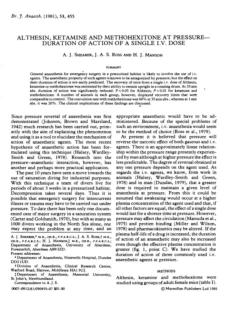

Authors: Bruce A. Freeman & James D. Crapo
This paper discusses the role of increased oxygen radicals
in lung damage during hyperoxia. It examines how
mitochondrial electron transport inhibition, using CN- or
antimycin A, affects oxygen uptake in rat lung slices and
isolated mitochondria. The study measures CN-resistant
respiration as an indicator of intracellular O2- and H2O2
production. Findings show that CN-resistant respiration
increases with higher oxygen levels in lung slices and
isolated mitochondria.
.



Authors: Bruce A. Freeman & James D. Crapo
This review examines the sources of free radicals, the
reactions they undergo, and the cellular defenses and
adaptive mechanisms that protect against their damage. A
free radical is a molecule with an odd number of
electrons, making it highly reactive and transient. The
damage caused by free radicals depends on their type
and where they are generated within the cell.



Author: R.D. Vann
This document, presented at the congress held in Toronto
in March 1984, aimed to assess the state of knowledge
regarding saturation diving decompression.



Authors: R.G. Eckenhoff, and R.D. Vann
The study examined 77 subjects undergoing
decompression from air or nitrogen-oxygen (nitrox)
saturation exposures at depths of 18.3 to 40.2 meters of
seawater (msw) using four different decompression
schedules. Results. The overall DCS incidence was 9%, all
being pain-only and localized to the knee. The US Navy
heliox saturation decompression schedule showed a
higher DCS incidence compared to other schedules.
Differentiation between nitrox schedules was inconclusive
due to the limited number of subjects and variable
exposures.



Author: C.A. Plantadosi
This USN document discusses the issue of convective
respiratory heat transfer in divers who breathe cold
helium-oxygen mixtures, which is a significant source of
body heat loss without effective thermoregulatory
compensation. It suggests a temperature-depth curve to
enable divers to gain heat from exercise, despite increased
respiratory heat loss due to exercise or cold, with excess
heat being dissipated through the skin as divers adjust
their hot water flow and temperature for comfort.
.



Authors: Christian Lemaire
This document reviews the research in Hyperbaric
Physiology. The writing was entrusted by the Hyperbaric
Physiology Committee of the National Center for Ocean
Exploitation (CNEXO) and the Directorate of Research and
Techniques (DRET) to Mr. Christian Lemaire, who
consulted specialists in this field. This update follows the
one that Professor L. Barthélémy wrote in 1972, titled
"Human Hyperbaric Biology - Where Are We in 1972?".


Author: Robert H. Logie & Alan Baddeley
This paper presents psychological observations from a
simulated dive to 660 meters of seawater (msw)
conducted in 1983 using a Trimix gas mixture (He-O-N2).
This was the deepest dive performed until the COMEX
Hydra 10 experimental dive reached 701 msw. The study
suggests that Trimix allows for faster compression with less
performance impairment compared to the traditional He-
O2 mixture. Data from two divers were collected on
cognitive performance tests, including arithmetic,
grammatical reasoning, perceptual speed, visuo-spatial
manipulation, and semantic processing.



This document, written in French, intends to present and
discuss the findings of a research study that compares the
ventilatory patterns of cats breathing different gas mixtures
during simulated deep-sea diving. It explains the effects of
using a helium-oxygen mixture versus a helium-nitrogen-
oxygen mixture on respiratory frequency and oxygen
transfer. It also explores potential reasons for the observed
changes in respiratory patterns, including the impact of
high helium pressures and the possible influence of the
High-Pressure Nervous Syndrome (HPNS).



Author: Richard d. Vann
This paper describes the development and application of a
theoretical method for predicting spacecraft and spacesuit
atmospheres, as well as to discuss the analysis of
decompression procedures and the study of
decompression sickness in rats. Additionally, it outlines a
method for developing decompression schedules for
helium/oxygen and nitrogen/oxygen saturation dives,
including the use of equations and examples for
calculating these schedules.



The paper intends to inform and describe the details and
significance of Operation HYDRA IV, a deep-sea diving
experiment conducted by COMEX in 1983. It highlights
the achievements of the operation, particularly the use of
a hydrogen-oxygen breathing mixture (Hydrox) at a
record depth, and positions it as a pioneering effort in
deep-sea exploration, and also provides context by
mentioning previous operations and the motivation
behind using Hydrox to overcome limitations of
conventional gas mixtures for deep diving.



Authors: Department of Anesthesiology and F.G. Hall
Laboratory Duke University Medical Center
Durham, North Carolina
The Third Annual Canadian Ocean Technology Congress
was held in Toronto on March 22, 1984. This event served
as a significant platform for professionals, researchers, and
industry leaders to convene and discuss advancements,
challenges, and innovations within the field of ocean
technology. The congress likely featured a series of
presentations, panel discussions, and networking
opportunities aimed at fostering collaboration and
knowledge exchange among participants dedicated to
the development and application of oceanographic
technologies.

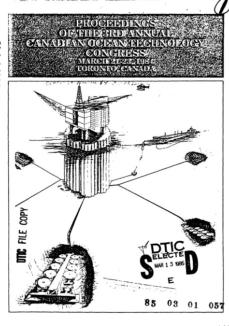

Authors: DR Leitch,
The document offers a comprehensive summary and
analysis of the experiences and outcomes of Royal Navy
saturation divers during deep-sea dives. It specifically
examines the incidence of decompression sickness and
evaluates the effectiveness of decompression tables at
various depths. The aim is to present findings and
conclusions concerning the safety and risks associated
with different diving depths and decompression practices.



Author: Kenneth W. Kizer
Auerbach and Miller compared high altitude flatus
expulsion (HAFE) syndrome to decompression sickness in
divers. However, HAFE is more similar to gastrointestinal
barotrauma, which happens when bowel gas expands
due to reduced pressure during ascent. Symptoms
include belching, gas expulsion, bloating, and abdominal
pain, sometimes leading to fainting or shock.


7 - Gastrointestinal Barotrauma


Authors: B.A Hills, & B.D. Butler
Thin-layer chromatography has identified phospholipids
from canine synovial fluid, with phosphatidylcholine (PC)
being the main component at 45%. These extracts
reduce water's surface tension and adsorb onto
hydrophilic solids, making them hydrophobic. The
adsorbed layers work well as lubricants, cutting down
friction by up to 97% for extracts and 99% for PC.
Surface-active phospholipids may aid in joint lubrication
and could help in artificial lubrication for arthritis patients.


35 - Surfactants identified in synovial fluid and their ability to act as
boundary lubricants.
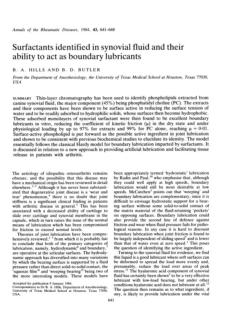

This document introduces a eight studies on the topics
mentioned by the following authors:
•
H.D. Van Liew and C.V. Paganelli
•
J.R. Clarke and L.D. Homer
•
D.D. Hickey, D.C. Marky, and R.J. Smith
•
Camporesi, J.V. Salzano, R.E. Moog, and B. Stolp
•
J.V. Salzano, E.M. Camporesi, R.E. Moon, and B. Stolp
•
K. Sejdal, R.E. Peterson, G. Bolstad, and J.E. Jacobsen
•
D.D. Hickey, C.E.G. Lundgren, D.R. Pendergast, and
H.T. Swanson
•
T.J. Doubt and D.B. Evans


14 - Abstract session: Ventilation - Gas exchange - Cardiovascular
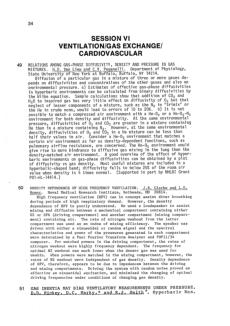

Authors:
A. O. Brubakk, S. Tonjum, B. Holand, R. E. Peterson, R.W.
Hamilton, E. Morild, and J. Onarheim
This document describes heat loss and tolerance time
during cold exposure in a heliox atmosphere at 16 ATA.
Four types of protective clothing and three heat
conservation methods were tested at 4°C. Divers with
less insulation had to stop after 1-2 hours due to severe
cold, while those with heavy insulation lasted 8-10 hours.
Respiratory heat loss remains significant unless the
inspired gas is heated using a heat-exchanger and
scrubber..


15 - Heat loss and tolerance time during cold exposure in heliox
atmosphere at 16 ATA
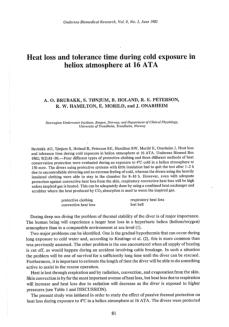

Authors:
P. B. Bennett, R. Coggin, and M. McLeod
This document describes a series of dives that tested the
effects of helium, nitrogen, and oxygen on divers at
extreme depths. The study compared 5% and 10%
nitrogen during fast compression to 460 m and then to
650 m over 2.5 days. In 1981, divers were compressed
more slowly to 650 m over 6 days using 10% nitrogen in
heliox. They stayed at 650 m for 4 days and then went to
686 m for 24 hours, undergoing various performance
tests. While there were some psychological effects and a
slight impairment in attention, divers performed well
overall. Slow compression helped reduce initial
performance drops experienced in earlier fast-
compression dives.


19 - Effect of compression rate on use of trimix to ameliorate HPNS
in man to 686 m (2250 ft)


Authors:
R.W. Brauer, P.M. Hogan, M. Hugon, A.G. Macdonald, &
K.W. Miller
This review examines how metabolically inert light gases
(He, H1, and Ne) interact with hydrostatic pressure and
their pharmacological effects on biological responses. It
identifies common patterns in how pressure influences
anesthesia reversal, convulsions, and bradycardia. The
study shows that no single gas can completely
counteract hydrostatic pressure effects across all
biological responses. Experiments indicate that certain
responses, such as cell motility and abnormalities, form a
distinct group that requires further study. The
implications for biophysical hypotheses and safety in
high-pressure environments are also discussed.


20 - Patterns of interaction of effects of light metabolically inert gases
with those of hydrostatic pressure as such—a review
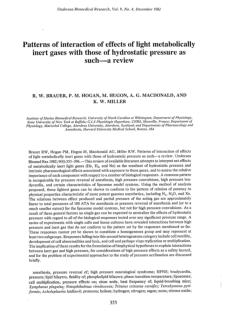

Author: J. Dwyer
The study examined how a diver's heart rate (HR) can
estimate oxygen uptake (VO2) during undersea work in
six scuba divers. Data were collected using a recording
system and gas sampler at different pressures. Results
showed that HR and VO2 varied significantly across
pressures, with only one significant difference in
regression slopes. The study concluded that HR
measurements are not reliable for estimating oxygen
uptake in underwater conditions, as they do not align
with sea-level standards.


25 - Estimation of oxygen uptake from heart rate response to
undersea work
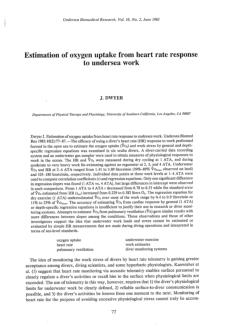

Authors: D. D. Hickey, C. E. G. Lundgren, AND A. J.
Pasche
This study examined how exercise affects maximal
voluntary ventilation (MVV) and forced expiratory flow
under different pressures. Results showed that MVV and
expiratory flow decreased with gas density but increased
during heavy exercise. CO2 inhalation had little impact
on MVV and a slight effect on flow.


29 - Influence of exercise on maximal voluntary ventilation and
forced expiratory flow at depth
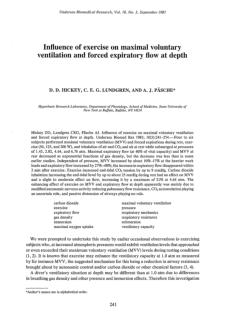

Authors: R. W. Brauer and W. M. Hinson
This study by Brauer and Hinson examines how different
patterns of nitrogen injection affect the development of
high pressure neurological syndrome (HPNS) in mice.
They found that excitement threshold pressures decrease
with higher nitrogen levels, and changing the injection
style does not impact this. Coarse tremors are delayed
based on nitrogen presence, with bolus injections being
less effective than continuous ones. Convulsion
thresholds rise with greater nitrogen amounts, and the
effects vary depending on the compression rate and
injection timing.


33 - Effects of variations in time pattern of nitrogen addition on
development of HPNS in mice


Authors: J. D. Geiger, T. K. Akers, and S. S. Parmar
The study investigated how different environments,
including normoxic air and helium-oxygen at two
pressures, affected drug-metabolizing enzyme activity in
rat liver. Rats exposed to helium-oxygen showed
significant increases in enzyme activities. The study noted
specific percentage increases in O-dealkylation and N-
dealkylation reactions between various conditions. No
significant differences were found for N-dealkylation of
cocaine.


34 - Effects of helium-oxygen and hyperbaric helium-oxygen
environment on drug-metabolizing enzyme activity in rat liver
